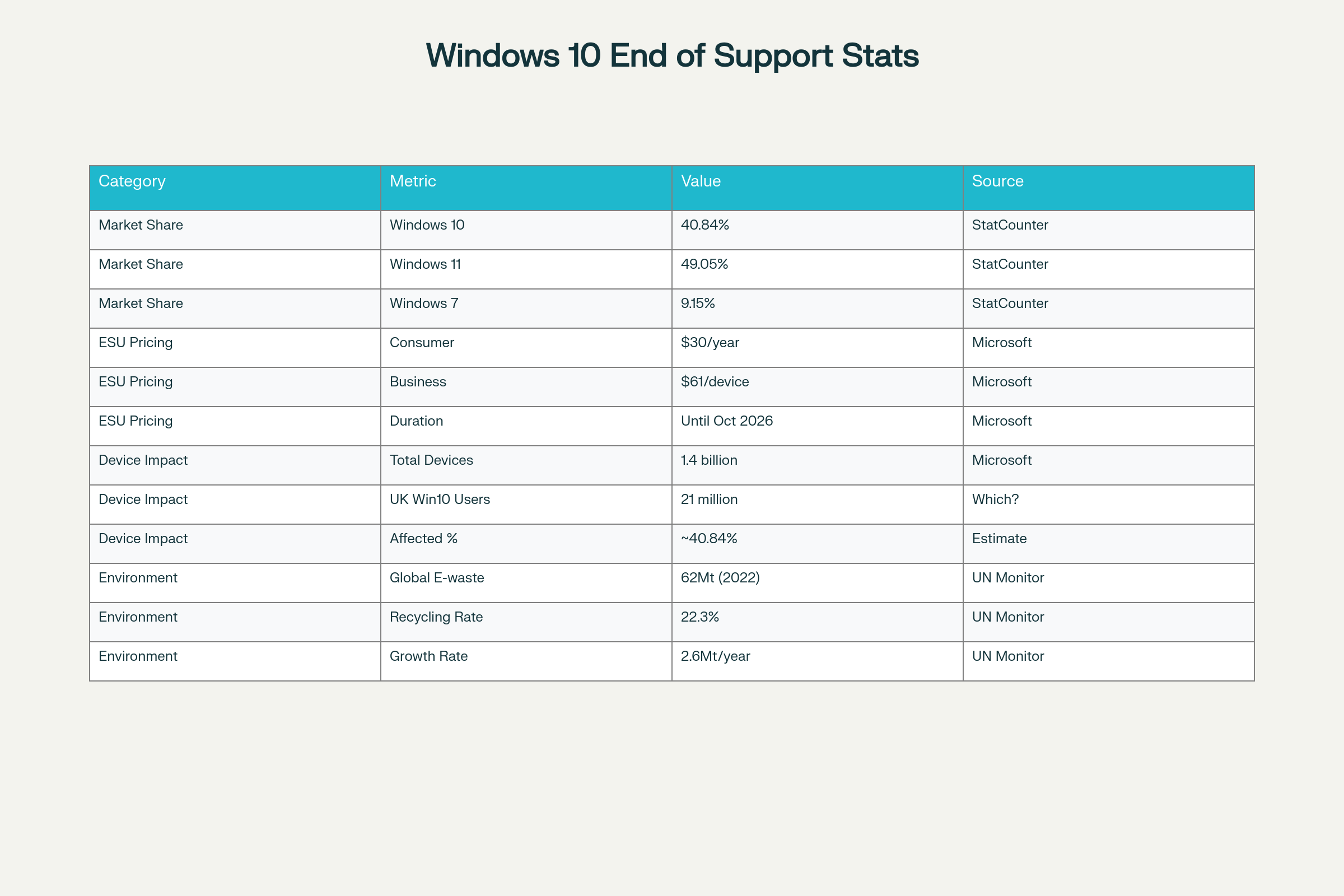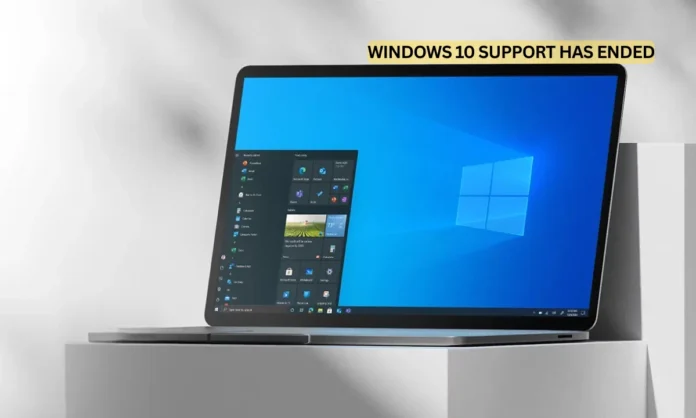Key Highlights:
- Microsoft officially ended Windows 10 support on October 14, 2025, affecting 40.84% of Windows users globally
- Extended Security Updates available for $30 annually for consumers, $61 for businesses, lasting until October 2026
- Environmental experts warn of massive e-waste crisis as millions of functional PCs may become obsolete
The technology landscape shifted dramatically on October 14, 2025, as Microsoft officially terminated support for Windows 10, leaving hundreds of millions of devices worldwide vulnerable to security threats. This monumental transition affects approximately 40.84% of the global Windows user base, representing roughly 571 million devices out of Microsoft’s reported 1.4 billion Windows installations. The Windows 10 end of support marks one of the most significant forced technology migrations in computing history, with far-reaching implications for cybersecurity, corporate compliance, and environmental sustainability.
The timing of this Windows 10 end of support decision coincides with growing concerns about digital security and electronic waste management. Consumer advocacy organizations and environmental groups have criticized Microsoft’s approach, arguing that the transition unnecessarily forces users to abandon perfectly functional hardware while creating unprecedented cybersecurity risks for those who cannot upgrade.
Security Vulnerabilities Expose Millions of Devices
The immediate aftermath of Windows 10 end of support creates a cybersecurity landscape fraught with unprecedented risks for both individual users and organizations. Microsoft will no longer provide critical security patches, bug fixes, or technical support for Windows 10, leaving systems increasingly vulnerable to malware, ransomware, and sophisticated cyber attacks that exploit unpatched vulnerabilities.
- Unsupported systems become prime targets for cybercriminals seeking easy entry points
- Corporate compliance requirements may be violated by continuing to use unsupported software
The security implications extend beyond individual devices to entire network infrastructures. Organizations running Windows 10 systems face potential regulatory penalties in heavily regulated industries where using unsupported software violates compliance standards. Cyberattacks have escalated across all sectors in recent years, with security experts emphasizing that unpatched systems provide attackers with well-documented entry points.
Microsoft’s Consumer Chief Marketing Officer Yusuf Mehdi specifically warned that “companies may find it challenging to maintain compliance with unsupported software,” highlighting the regulatory risks associated with continuing Windows 10 end of support operations. The cybersecurity community has documented numerous cases where legacy systems became the weakest link in otherwise secure network environments.
Extended Security Updates: Limited Lifeline with Significant Costs
Microsoft offers Extended Security Updates (ESU) as a temporary bridge for users affected by Windows 10 end of support, though the program comes with substantial limitations and costs. Consumer users can purchase ESU for $30 annually, while business customers face significantly higher costs of $61 per device for the first year, with prices doubling each subsequent year.learn.
- ESU provides critical security patches through October 2026 but excludes new features and technical support
- European Economic Area residents receive ESU at no additional cost, while others must pay or use Microsoft Rewards points
The ESU program represents a limited safety net rather than a comprehensive solution to Windows 10 end of support challenges. Business organizations managing thousands of devices face potentially massive costs, with enterprise pricing escalating dramatically in years two and three of the program. The program explicitly excludes new features, performance improvements, and comprehensive technical support, providing only essential security patches.
Consumer ESU access requires a Microsoft account, raising privacy concerns among users who prefer local account management. The program’s one-year duration for consumer users, compared to three years for enterprise customers, reflects Microsoft’s strategy to push individual users toward hardware replacement rather than extended software support.

Key Statistics: Windows 10 End of Support Impact Analysis
Hardware Compatibility Barriers Block Upgrade Paths
The transition challenge intensifies due to Windows 11’s stringent hardware requirements that exclude millions of otherwise functional computers from upgrading. Microsoft’s Windows 11 demands TPM 2.0 security chips, UEFI firmware, Secure Boot capability, and eighth-generation Intel processors or AMD Zen+ architecture, effectively blocking devices manufactured before 2017-2018 from official support.
- TPM 2.0 requirement alone disqualifies most consumer motherboards from the pre-2018 era
- Processor compatibility lists exclude seventh-generation Intel and first-generation AMD Ryzen chips
The compatibility restrictions create an artificial obsolescence cycle for hardware that remains fully functional for typical computing tasks. Industry analysis reveals that most PCs manufactured before 2018 lack the required TPM 2.0 security hardware, despite being capable of running modern software applications effectively. Microsoft’s processor whitelist approach particularly affects users with seventh-generation Intel Core processors, which represented mainstream computing just five years ago.
Research indicates that enabling TPM 2.0 on existing hardware requires BIOS modifications that many users find technically challenging, creating additional barriers to Windows 10 end of support transition. The PC Health Check application provided by Microsoft often delivers disappointing results for users hoping to upgrade existing systems to Windows 11.
Environmental Crisis: E-Waste Generation Accelerates
The environmental implications of Windows 10 end of support represent perhaps the most concerning long-term consequence of Microsoft’s transition strategy. Global e-waste generation reached 62 million tonnes in 2022 and continues growing at 2.6 million tonnes annually, with technology transitions contributing significantly to this acceleration.
- Electronic waste recycling rates remain insufficient at just 22.3% globally, expected to decline to 20% by 2030
- Personal computers and related hardware contributed 5.5 million metric tonnes to global e-waste in 2010 alone
Nathan Proctor, senior director at the US consumer advocacy group PIRG, characterized the Windows 10 end of support transition as “a disaster for both consumers and the environment,” emphasizing how artificial software limitations force replacement of functional hardware. The environmental justice implications extend beyond developed nations, as discarded electronics often end up in developing countries with inadequate disposal infrastructure.
The World Health Organization identifies e-waste as containing toxic substances including mercury, which damages human brain function and coordination systems. Electronic waste grows five times faster than documented recycling efforts, creating mounting environmental and public health challenges. The Windows 10 end of support transition threatens to accelerate this crisis by forcing premature replacement of millions of functional computers worldwide.
Corporate and Consumer Response Strategies
Organizations and individual users face difficult strategic decisions as Windows 10 end of support reality sets in across various sectors. Survey data from the UK consumer organization Which? reveals that approximately 25% of Windows 10 users intend to continue using the unsupported system, while only 14% plan to purchase new computers.
- Enterprise customers increasingly evaluate ESU costs against hardware replacement expenses
- Consumer behavior shows resistance to forced upgrades, with some users reportedly reverting to Windows 7
The corporate response varies significantly across industries, with heavily regulated sectors facing immediate pressure to migrate or implement ESU programs to maintain compliance standards. Technology officers report reviewing entire IT refresh cycles to accommodate Windows 10 end of support requirements, often accelerating planned hardware replacement schedules.
Consumer resistance to the transition appears stronger than Microsoft anticipated, with StatCounter data showing Windows 7 market share unexpectedly increasing to 9.15% in September 2025, potentially indicating user dissatisfaction with available upgrade options. This anomalous trend suggests that some users prefer returning to a familiar, albeit unsupported, operating system rather than accepting Windows 11’s hardware requirements.
Closing Assessment of the Windows 10 Transition
The Windows 10 end of support transition represents more than a routine software lifecycle event, embodying broader tensions between technological progress, consumer choice, and environmental responsibility. Microsoft’s decision affects approximately 571 million devices worldwide, creating immediate security vulnerabilities while potentially generating millions of tonnes of additional electronic waste.
The confluence of factors surrounding Windows 10 end of support highlights systemic challenges in the technology industry’s approach to product lifecycle management. Users face an unprecedented choice between accepting security risks, paying ongoing fees for limited support, or replacing functional hardware due to artificial software restrictions.learn.
The long-term implications extend beyond individual inconvenience to encompass cybersecurity infrastructure, environmental sustainability, and digital equity concerns. As millions navigate the Windows 10 end of support transition, the decisions made in coming months will shape precedents for future technology transitions and corporate responsibility in the digital age.


